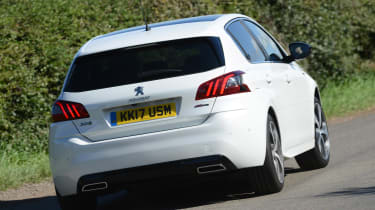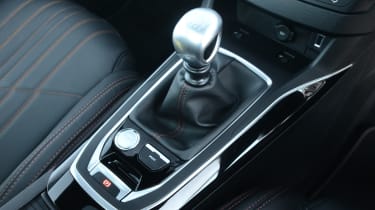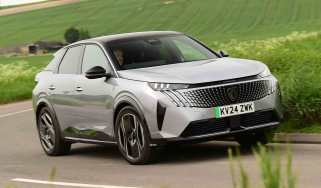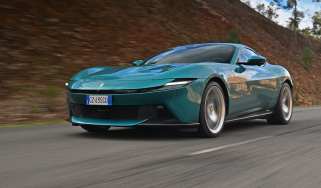Peugeot 308 (2013-2021) review - Engines, performance and drive
Strong engine range complements a supple chassis that makes the 308 a great all-rounder

The latest 308 has a strong balance of ride and handling. As indicated by the classy looks and interior, the focus of the mainstream models is on good long-distance cruising comfort: low noise levels, a supple ride and good stability make the Peugeot a fuss-free choice in everyday use. There are no changes to this for the 2017 update. The 308 is based on Peugeot’s versatile EMP2 platform, which also underpins the 3008 and 5008 SUVs. It uses the same MacPherson strut front and torsion beam rear suspension layout as a result.
It’s not soft or soggy, though. The car is much sharper to drive than older 308s, with decent turn-in and fair agility in corners. Over-assisted, artificial-feeling steering does cloak some of this, but it’s still an enjoyable car that doesn’t roll or wallow over twisting roads. It can get caught out by mid-corner bumps, however, particularly on cars with the largest wheel size.
In mid-spec Allure trim, the 308 serves up assured and agile handling. The quick steering and small wheel deliver sharp turn-in, while once settled into a corner, the Peugeot provides strong grip and good body control. It’s not as engaging as an Astra or as comfortable as a Renault Megane, but it offers a decent ride and handling balance. However, while the 308’s suspension does a decent job of soaking up bumps, there’s more wind and road noise than you’ll find in newer rivals.
Used - available now
GT models are firmer (their suspension is up to 10mm lower than on the equivalent GT Line version), but they remain comfortable, and the GT’s larger 18-inch alloys can give a more uncomfortable ride than models on smaller rims. The extra grip of this version is welcome though, and it’s a convincing warm hatch.
Stepping things up again is the 308 GTi, with a very focused chassis that proves Peugeot still knows what it takes to make a great hot hatch.
Engines
Historically, diesel engines have been quite popular in the 308, and despite favour swinging towards petrol, Peugeot isn't ready to ditch the black stuff entirely. To reflect this, a cleaner 1.5-litre diesel engine arrived in 2017, and it has now completely replaced the older 1.6 BlueHDi in the range.
The 1.5 feels largely similar to the outgoing 1.6. There's a 99bhp version, which should be better than the old 99bhp 1.6 just for the fact it comes with a more flexible six-speed gearbox as standard. The 128bhp version is slightly more powerful than most potent outgoing 1.6, although the performance difference is unlikely to be noticeable. It's slightly more refined, though. The main advantage is that it uses Selective Catalytic Reduction (SCR) to reduce harmful local emissions.
The 2.0-litre engine, was offered with 148bhp for a while, but now it just comes in 178bhp BlueHDi 180 guise. It's a little less refined than the newer 1.5, but its stronger performance makes this easy to forgive. It's only available with the EAT8 auto box, while 0-62mph takes 8.2 seconds.
The petrol engine choices are Peugeot's 1.2 PureTech turbo three-cylinder and 1.6 PureTech four cylinder. The 1.2-litre was previously available in non-turbo 81bhp guise, but this was dropped in 2017. The range now kicks off with a 108bhp turbo PureTech 110, which manages 0-62mph in 11.1 seconds, has a top speed of 117mph and offers 205Nm of torque delivered from just 1,500rpm. The 1.2-litre engine is virtually inaudible at idle and remains muted when extended, but there is a distant offbeat growl as the rev counter hits the red line.
The PureTech 130 lifts things further, with 0-62mph taking 9.6 seconds, a top speed of 129mph and torque swelling to 230Nm. It also has a six-speed manual gearbox as standard, or the optional EAT8 eight-speed auto. All PureTech engines have a pleasant throbbing engine note and the torque of the turbo makes them easy to drive and impressively refined. They’re very grown-up, appealing engines.
The sporty-feeling 1.6-litre PureTech comes with 222bhp or 256bhp in the GTi, delivered at an identical 6,000rpm. Even the PureTech 205 does 0-62mph in 7.4 seconds – a significant performance step up over other 308 engines. The GTi manages it in just 6.0 seconds, with both hitting a 155mph top speed. A healthy torque output of between 285Nm and 330Nm from less than 2,000rpm proves that this motor is as flexible as it is powerful – again, it’s ultra-smooth and appealing to use, too.
Curiously, the 1.6-litre PureTech can't be had with the EAT8 automatic gearbox: all versions are hooked up to a six-speed manual. We think the auto box would suit it well.
More reviews
In-depth reviews
Long-term tests
Which Is Best
Most Economical
- Name1.6 Plug-in Hybrid 195 Allure 5dr e-DSC7
- Gearbox typeSemi-auto
- RRP£38,110











